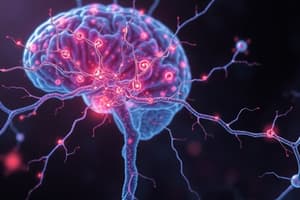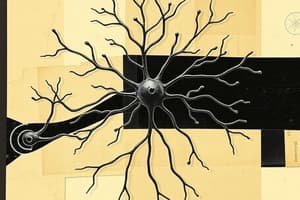Podcast
Questions and Answers
Which type of neuron is characterized by a single dendrite and a single axon associated with the cell body?
Which type of neuron is characterized by a single dendrite and a single axon associated with the cell body?
- Bipolar neuron (correct)
- Unipolar neuron
- Pseudounipolar neuron
- Multipolar neuron
What is the primary function of unipolar neurons?
What is the primary function of unipolar neurons?
- Interneuron tasks
- Sensory function (correct)
- Regulatory functions
- Motor function
Which layer of the meninges is the outermost and the strongest?
Which layer of the meninges is the outermost and the strongest?
- Arachnoid mater
- Pia mater
- Dura mater (correct)
- Subarachnoid space
What fills the subarachnoid space that bathes and protects the brain and spinal cord?
What fills the subarachnoid space that bathes and protects the brain and spinal cord?
What is a key characteristic of multipolar neurons?
What is a key characteristic of multipolar neurons?
During embryonic development, which type of neuron initially starts as bipolar?
During embryonic development, which type of neuron initially starts as bipolar?
Which layer of the meninges adheres directly to the surfaces of the brain and spinal cord?
Which layer of the meninges adheres directly to the surfaces of the brain and spinal cord?
What type of neuron is most common in the central nervous system (CNS)?
What type of neuron is most common in the central nervous system (CNS)?
What is the name given to the cytoplasm of muscle fibers?
What is the name given to the cytoplasm of muscle fibers?
Which of the following types of muscle is characterized as non-striated?
Which of the following types of muscle is characterized as non-striated?
What characteristic feature differentiates cardiac muscle fibers from smooth muscle fibers?
What characteristic feature differentiates cardiac muscle fibers from smooth muscle fibers?
Which part of the nervous system is comprised of the brain and spinal cord?
Which part of the nervous system is comprised of the brain and spinal cord?
What is the function of neuroglia in the nervous system?
What is the function of neuroglia in the nervous system?
What is true about the nuclei in skeletal muscle cells?
What is true about the nuclei in skeletal muscle cells?
Which type of neuron is characterized by having one axon with no dendrites?
Which type of neuron is characterized by having one axon with no dendrites?
Smooth muscle can be primarily found in which of the following locations?
Smooth muscle can be primarily found in which of the following locations?
Flashcards are hidden until you start studying
Study Notes
Neuronal Types
- Unipolar Neurons: Initially bipolar during embryonic development, they fuse into a single process later. They are sensory and found in cranial and spinal nerve ganglia.
- Bipolar Neurons: Less common than unipolar, these are purely sensory. They have a single dendrite and a single axon connected to the cell body. Found in the retina.
- Multipolar Neurons: Most common type in the central nervous system (CNS). They include all motor neurons and interneurons of the brain, cerebellum, and spinal cord. Characterized by numerous branched dendrites and a single axon.
Protective Layers of the CNS
- Dura Mater: The outermost, strong, thick layer of dense connective tissue.
- Arachnoid Mater: Delicate connective tissue layer located deep to the dura mater. These two layers surround the brain and spinal cord externally.
- Pia Mater: The innermost, delicate connective tissue layer. It contains numerous blood vessels and adheres directly to the brain and spinal cord surfaces.
- Subarachnoid Space: Lies between the arachnoid mater and the pia mater. It contains cerebrospinal fluid (CSF) which bathes and protects the brain and spinal cord.
Muscle Tissue
- Sarcolemma: The plasma membrane of muscle fibers.
- Sarcoplasm: The cytoplasm of muscle fibers.
Types of Muscle:
- Skeletal Muscle: Long, cylindrical, multinucleated cells with peripheral nuclei. They are attached to bones.
- Smooth Muscle: Appear smooth (non-striated), with a single central nucleus. Found in the linings of visceral hollow organs and blood vessels.
- Cardiac Muscle: Cylindrical fibers with one or two central nuclei. They exhibit intercalated disks, dense-staining junctions at the ends of adjacent fibers. Primarily located in the aorta and pulmonary trunk.
Nervous Tissue
- Central Nervous System (CNS): Consists of the brain and spinal cord.
- Peripheral Nervous System (PNS): Includes the cranial and spinal nerves, located outside the CNS.
Structure of a Neuron:
- Soma or Cell Body: The main body of the neuron.
- Dendrites: Branched extensions that receive signals from other neurons.
- Axon: A single, long extension that carries signals away from the cell body.
Supporting Cells in the CNS: Neuroglia
- Astrocytes: Star-shaped cells that provide structural support, regulate the chemical environment, and help form the blood-brain barrier.
- Oligodendrocytes: Form myelin sheaths around axons in the CNS, enhancing signal conduction speed.
- Microglia: Act as immune cells in the CNS.
- Ependymal Cells: Line the cavities of the brain and spinal cord, producing and circulating cerebrospinal fluid.
Types of Neurons in the CNS:
- Unipolar Neurons: As described earlier, these are sensory neurons.
- Bipolar Neurons: Also described earlier, these are sensory neurons.
- Multipolar Neurons: As described earlier, these are motor neurons and interneurons of the CNS.
Studying That Suits You
Use AI to generate personalized quizzes and flashcards to suit your learning preferences.




